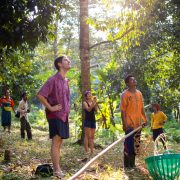Finding answers where there may be no solutions
By Jason Karpman, MURP ’16 & International Practice Pathway Fellow
At the outset of this blogging exercise I posed two questions that I hoped to answer during my time in Thailand: (1) given the consequences of global warming, should remaining arable land be used to grow food or plant trees?; and (2) if everything is impermanent, is our environment (as we know it) even worth fighting to save? While I don’t have a conclusive answer to either question, my summer fellowship at least gave me enough clarity on the issue of climate change (both in terms of how to address it and why to address it) that I feel comfortable getting on with my life and doing something about it, even in the face of ultimate futility.
As it turns out, food production and forestation are not necessarily in direct conflict with one another, and have the potential to synergistically interact. Having spent the past three months reviewing academic papers on the benefits of agroforestry systems, I can say with great confidence that there are a number of compelling case studies in which tree cover has actually improved crop yield, rather than diminished it (Saka et al. 1994, Makumba and Maghembe 1999, Akinnifesi et al. 2006, Ajayi 2007). Yes, trees take up valuable real estate on agricultural land, but they also cycle nutrients, control erosion, and minimize evaporation, all of which are important for soil fertility and structure, which strongly influence yield. To top it off, trees can also be crops themselves (i.e., fruits and nuts), further influencing onsite productivity.
Of course, there are some instances in which incorporating trees into agriculture results in tradeoffs, rather than synergies. Trees have competed with crops for light (Friday and Fownes 2002), soil moisture (Unkovich et al. 2003), and nutrients (Thevathasan 2004), thereby reducing yield, but these mismatches shouldn’t be the last word on agroforestry. Tree and crop interactions are highly variable, both according to species mix and environmental conditions such as climate and soil, and it’s important to explore those interactions across as many permutations as possible. In fact, “important” might be an under statement, our very survival (along with the survival of many other living organisms) depends upon our ability to slow climate change while still putting food on the table.
To answer my second question, I ventured beyond my usual comfort zone (i.e., the Web of Science portal) and attended a monk chat, a long standing tradition in Chiang Mai in which monks essentially hold “office hours” to answer questions from tourists and novice Buddhists about their beliefs and practices. I felt a bit ridiculous coming to a monk chat to talk about climate change, since my question was so laden with privilege (in much of the world, climate change is an everyday threat, not an existential threat), but my anxiety over the issue was real, albeit a lucky one. So after 10 weeks of hemming and hawing, I finally made it to a monk chat on my very last day in Chiang Mai.
I spoke to two monks and got very different responses. The first monk encouraged me to find resolution through meditation. While I appreciated the advice (I could certainly benefit from more meditation in my life), the response ultimately left me feeling defeated. It was as if to say: worrying about the future is pointless, so forget about climate change and focus on the present moment. A valid suggestion for finding emotional peace with environmental and human loss, but that peace would have to come at the cost of using my time on planet earth to actually work on resolving the underlying issues.
The second monk instead responded to my question with a question: does your work make you happy? Without hesitation I said yes. And that was more or less where the conversation ended because his point was clear: life isn’t about permanently solving problems (an impossible task), it’s about finding meaning in the act of problem-solving, as if it were its own form of meditation. Framed from that perspective, acceptance and activism no longer seemed so at odds with each other. Yes, climate change is likely to get worse during my lifetime, and even if I devote my life to trying to reverse that trend, I accept failure. However, I’m still not going to throw in the towel, I’m having too much fun in the ring.
References:
Ajayi O.C. (2007) User acceptability of soil fertility management technologies: lessons from farmers’ knowledge, attitude and practices in southern Africa, J. Sustain. Agr. 30: 21–40.
Akinnifesi F.K., Makumba W., Kwesiga F. (2006) Sustainable Maize Production using Gliricidia / maize intercropping in Southern Malawi, Exp. Agr. 42: 441–457.
Friday J.B., Fownes J.H. (2002) Competition for light between hedgerows and maize in an alley cropping system in Hawaii, USA. Agroforestry Systems 55: 125–137.
Makumba W.I.H., Maghembe J.A. (1999) Nitrogen dynamics in two agroforestry technologies practiced by smallholder farmers in the southern part of Malawi, in: Ayuk E., Dery B., Kwesiga F. Makaya P. (Eds.). Proceedings of the 13th Southern African Regional Planning and Review Meeting, 5–11 July 1999, Mangochi, Malawi,
Saka A.R., Bunderson W.T., Itimu O.A., Phombeya H.S.K., Mbekeani Y. (1994) The effects of Acacia albida on soils and maize grain yields under smallholder farm conditions in Malawi, For. Ecol. Manage. 64–230.
Thevathasan N.V., Gordon A.M., Simpson J.A., Reynolds P.E., Price G., Zhang, P. (2004) Biophysical and ecological interactions in a temperate tree-based intercropping system. Journal of Crop Improvement 12: 339–363.
Unkovich M., Blott K., Knight A., Mock I., Rab A., Portelli, M. (2003) Water use, competition, and crop production in low rainfall, alley farming systems of south-eastern Australia. Australian Journal of Agricultural Research 54: 751–762.





